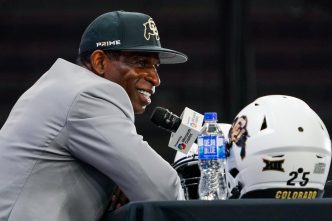In an instant classic last Saturday night, college football fans across the country were treated to a memorable showdown between the Ohio State Buckeyes and the Oregon Ducks.
As we all know, Oregon came out on top by the score of 32-31.
Whether it was by way of the refs or Oregon head coach Dan Lanning, Buckeye fans left Eugene with plenty of complaints.
Regardless, it was a tightly contested battle – one that not only lived up to the hype but exceeded it.
Oregon’s victory over the Buckeyes helped the Ducks remain undefeated and jump to No. 2 in the AP poll, but it also reignited discussions about the financial resources powering elite college football programs.
Washington head coach Jedd Fisch, whose team has struggled at times this season, commented on the financial muscle behind powerhouse programs, such as both Ohio State and Oregon.
“We all saw what the Ohio State-Oregon game looked like. That was a battle of two $20 million rosters,” Fisch said during a press conference earlier this week.
Fisch’s claim was not an exaggeration when it comes to Ohio State.
Athletic director Ross Bjork previously confirmed that the Buckeyes’ NIL collectives spent around $20 million to build their current roster.
This includes retaining standout players like TreVeyon Henderson and Emeka Egbuka while also bringing in high-profile transfers such as Will Howard, Quinshon Judkins, and Caleb Downs.
As Nick Saban said, the 2024 Ohio State Buckeyes are the best team money can buy.
Although Oregon hasn’t offered an official estimate on their NIL spending, it’s widely known that the Ducks benefit from the financial backing of Nike co-founder Phil Knight, who is said to provide the team with an “unlimited” budget.
While that number may be disputed, Lanning acknowledged in July that Oregon’s financial situation is very unique.
“Is our situation different than other teams in the nation? Absolutely,” Lanning said. “Is our team’s situation different than the premier teams in the nation? Probably not. And that’s OK. We want to be in that [group].”
Despite Lanning downplaying the idea of an “unlimited” budget, Oregon’s ability to bring in top-tier talent has kept them in the national championship conversation.
This offseason, they landed quarterback Dillon Gabriel from Oklahoma, adding to a roster full of high-impact transfers.
As Oregon and Ohio State continue their march toward potential playoff berths, other programs are left grappling with the growing financial gap.
While Washington won’t face Ohio State this season, the Huskies close out their regular season with a rivalry game against Oregon – a contest that will serve as a reminder of the impact big budgets can have on the field.
We all know it’s a brand-new world in college football.
With NIL and the transfer portal in full-effect, college football is inching closer to an NFL structure. In many ways, it’s already past the NFL when it comes to “free agency,” since coaches don’t only have to recruit high school players and transfers, but also their own players who are already on the roster.
Old-school coaches like Saban and Dabo Swinney have alluded to college football becoming a virtual “pay-for-play” sport where players are simply hired-guns who go to the highest bidder.
Some love that model. Some hate it. But until serious guardrails are put into place, this is how it’s going to be.
What are your thoughts on Fisch’s comments? … Where do you stand on the whole NIL debate???







